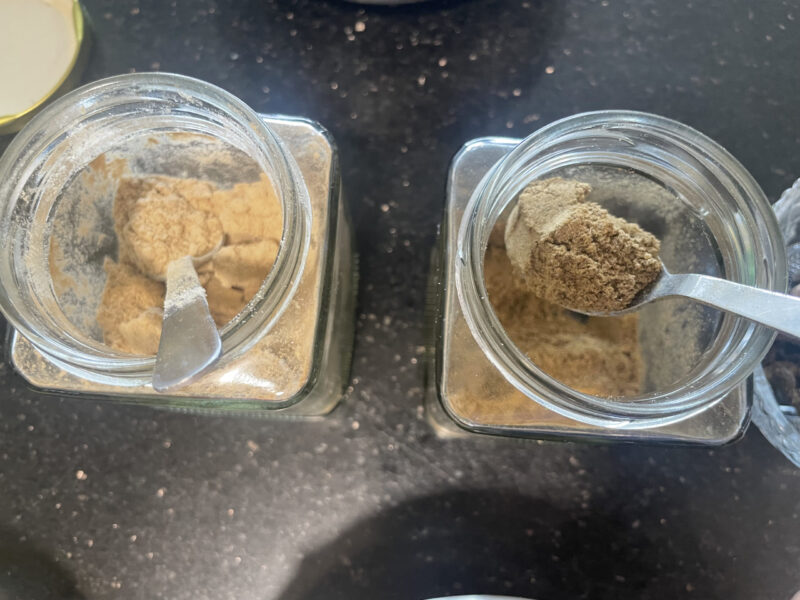
For onion paste:
| Onion, medium | 1½ |
|---|
For cashew paste:
| Cashew nuts | 10-12 |
|---|
For the kebab:
| Gram flour/Sattu, roasted | 2 tablespoons |
|---|---|
| Proso millet grains | ½ cup |
| Water | 1 cup |
| Ginger paste | 1 teaspoon |
| Garlic paste | 1 tablespoon |
| Salt | to taste |
| Yam, boiled and peeled | 250 grams |
| Amchoor powder | ½ teaspoon |
| Kewra water | ¼ teaspoon |
| Rose water | ½ teaspoon |
| Fried onion paste | 1 tablespoon |
| Cashew paste | 1 tablespoon |
| Ghee | 7 tablespoons |
| Vegetable oil | ½ cup |
For the kebab masala:
| Kebabchini/Tailed pepper, dry roasted | 20 grams |
|---|---|
| Pipli/Long pepper, dry roasted | 20 grams |
For the garam masala:
| Grated nutmeg | 2 pinches |
|---|---|
| Black cardamom | 2 |
| Cloves | 8 |
| Poppy seeds | 1 teaspoon |
| Black peppercorns | 6 |
| Cinnamon | ½ inch piece |
| Mace | ½ blade |
| Green cardamom | 8 |
| Chilli powder | 1 teaspoon |
What You Will Need
Mixing bowls, a mixer-grinder, measuring cups and spoons, a frying pan, a spatula, a fine-mesh colander or sieve, a spatula or turner.
Instructions
For the pre-preparations:
- Thinly slice the onions and deep-fry them in vegetable oil. Grind this into a paste. This will yield 1 tablespoon of fried onion paste.
- Dry-roast the spices mentioned under ‘garam masala’ and ‘kebab masala’ separately. Cool the spices down to room temperature, then grind them separately to form smooth powders. Reserve separately.
- Soak 10 to 12 broken cashew nuts in hot water for an hour. Drain the water, then grind the cashews to a smooth paste.

Place the proso millet grains and one cup of water in a pressure cooker. Add the ginger and garlic pastes to the grains, and salt to taste. Cook on a medium-high flame until the pressure cooker releases one whistle, then turn down the flame to low and cook for 10 more minutes. Turn off the flame and let the steam release. Once cooked, the grains will be soft to touch.

Meanwhile, grind the boiled yam in a mixer grinder. Place it in a large mixing bowl. Mix in the fried onion paste, the cashew paste, 2 teaspoons of the garam masala, and 2 teaspoons of the kebab masala, along with amchoor, kewra water, and rose water.
Grind the boiled proso millet in the mixer grinder for a semi-smooth consistency. Tip this into the yam-kebab mixture. Mix everything together and knead well. When the kebab mixture feels smooth, add the roasted gram flour and gently combine everything together with a spatula.

Refrigerate this kebab mixture for approximately 4 to 5 hours, to allow the flavours to blend properly.

Remove the kebab mixture from the refrigerator. Grease your palms, and a plate, with oil. Spoon a dollop of the kebab mixture onto your palm and flatten it using the other palm. Gently slide the kebab onto the plate. Shape and set aside all the kebabs similarly.
Pour ghee into a flat-bottomed iron kadhai or frying pan and allow it to melt on a low to medium flame.
Once the ghee has melted, use greased hands to gently place the kebabs onto the pan without overcrowding the pan.
Let the kebabs fry on low to medium heat. Keep turning them to allow for even cooking. When the kebabs appear ready, increase the flame to high, so that the exterior becomes crisp.
Gently scoop the kebabs out once done. Serve with green chutney and onion rings.

Tips:
- Keep the kebab mixture in the refrigerator as it helps shape the kebabs better.
- Soak the proso millet grains for a minimum of 4 hours before cooking. Drain the water and wash the grains again before cooking—this will make them swell to their full size.
Variations:
- The kebabs can be prepared using seasonal vegetables like jackfruit, sweet potato, or raw bananas instead of yam. The taste and texture of each of these kebabs will vary.
- Instead of proso millet, barnyard millet or sorghum can also be used.
Sahiba Khurana is a chemical engineer by qualification, but is mostly found in her kitchen, which she lovingly calls her “lab”. She enjoys developing innovative recipes using millets and is interested in subjects such as circular food economy, upcycled food products, and climate-resilient food systems.
You must be logged in to rate this recipe.

Sign in with email
